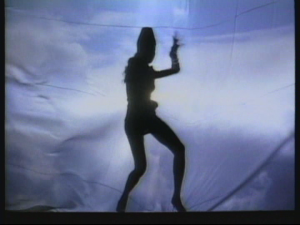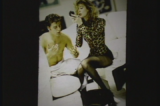 This documentary, part of Bill Moyer’s PBS series, The Public Mind, looks at a society inundated with visual images. “We live in a world of the mass producing and consuming of images which shape our lives and the public mind” says Moyers.
This documentary, part of Bill Moyer’s PBS series, The Public Mind, looks at a society inundated with visual images. “We live in a world of the mass producing and consuming of images which shape our lives and the public mind” says Moyers.
From tv to billboards, magazines to bus stops, news stands to rock videos, mass-produced images have become the very air we breathe. (This film was made in 1989, before the web!). What is this cultural atmosphere saying to us and about us? Why should we care? Ever since the pioneers of public relations and advertising spoke about the “engineering of consent,” social critics have analyzed its effects. For some, it reveals pure manipulation — the appropriation of language and meaning, the trivializing of life and thought. For others, it is the dawning of a new era — the printed word is dead and art and commerce are now joined in ever more sophisticated ways. “If our most prolific image is the commercial, the stakes are not only about meaning, but about citizenship and our democracy, truth and beauty” claims Moyers.
In the film we meet several scholars who study, write and teach about this new visual landscape raising questions about the merging of image-making and commerce. Neil Postman at NYU analyzes individual commercials and warns “the environment created by language and the printed word has been moved to the periphery of the culture. At its center the image has taken over.” Postman worries about what happens to our sense of truth when we sit before tv commercials.

Anthea Disney is Editor in Chief of “Self,” a fashion and beauty magazine in the Conde Naste stable, where, like all fashion magazines, editorial features are also ads. She describes this new era where women want to look luscious and so the magazines are working as fast as they can to appeal to that which raises the question of what comes first? Behavior? Or the image? Desire? Or the commercial and the ad?
Stuart Ewen, Professor of Media Studies at Hunter College, City University of New York, is author of “All Consuming Images” which takes on the commercial nature of this “air we breathe.” Ewen raises profound questions about the history of image-making and how much it has become separated from the sacredness and significance of the past and now is almost always embedded with persuasion and merchandising. He also describes how the commercial drive for larger and larger audiences now defines television news making and reporting.

Michael Singer, News Director at KTCU – the CBS affiliate in L.A. – candidly reveals that a mentor warned him to not take himself too seriously, “He said ‘remember that you are simply filling the black space between the commercials.”
We attend a class about critical media studies taught by Mark Crispin Miller, Professor at Johns Hopkins University, who argues that “advertising has become the primary mode of public address.”
Ann Kaplan, who directs the Humanities Institute at New York State University at Stonybrook, has written about the new landscape of rock videos — a genre that has finally completed the fusion of program and advertising in television. On MTV, rock videos are the program and they are all commercials.
At UC San Diego, Professor Herbert Schillerlooks carefully at advertising: “These images are the basis of our daily decisions, expectations and our view of the world and how we should be in it…they shape what our behavior is going to be.” Author of Culture, Inc. Schiller traces the concentration of media ownership and therefore the concentration of production of imagery under increasingly fewer commanders. Gigantic corporations like Time Warner bring cable tv, entertainment and news production, along with magazines under one roof.
For all of these scholars and teachers, teaching critical analytical skills in the classroom is essential for a new generation to navigate this saturated landscape of commercial imagery.
Funders: Markle Foundation, Schumann Foundation, Johnson & Johnson Co.






One of my all-time favorites! Showed it to students for at least a decade after and and a few clips for up to 20 years after. Beautiful, thoughtful, endlessly stimulating production!